Le opere di Staccioli non sono di certo nuove all’occhio attento dei capresi, degli habituè e dei vacanzieri che scelgono l’isola come meta estiva.
Artista toscano noto internazionalmente per le sue sculture e ceramiche, partecipa al percorso espositivo itinerante lungo Via Camerelle e nella piazzetta Cerio di Capri studiato da Liquid Art System. Più volte scelto per le mostre en plein air, Paolo Staccioli porta in mostra personaggi fantastici, guerrieri, viaggiatori, cardinali, cavalli. Figure del mito e del quotidiano, scolpite in bronzo, collocati in una dimensione al di fuori del tempo.
Nato nel ’43 Staccioli inizia il suo percorso artistico negli anni Settanta, esordendo come pittore. Al principio degli anni novanta la necessità di sperimentare nuovi linguaggi espressivi lo spinge a Faenza, nella bottega di un ceramista locale, Umberto Santandrea, dove apprende le tecniche di quest’arte. Qui Staccioli realizza i suoi primi vasi, dapprima con la tecnica della ceramica invetriata, poi sperimentando la cottura a “riduzione”, che gli consente di ottenere straordinari effetti d’iridescenza e lucentezza. Ottenuta assoluta padronanza del mestiere, Staccioli allestisce nel suo studio di Scandicci, nei pressi di Firenze, un laboratorio, dove continua autonomamente e quotidianamente a misurarsi con l’uso del fuoco e degli ossidi di rame, dando vita a una miriade di vasi che riveste con fantastici racconti pittorici, fissati definitivamente dalla smaltatura a lustro. I personaggi che popolavano la superficie delle sue ceramiche presto si guadagnano la terza dimensione, divenendo sculture che tuttavia non perdono l’accento di accadimento fiabesco, estranee come sono ad ogni nozione di tempo e luogo: forme idealizzate memori della statuaria preromana, etrusca in particolare, sulle quali interviene la policromia della ceramica, a rendere un vigoroso effetto di masse in contrasto. Guerrieri, viaggiatori, cardinali e cavalli si aggiungono ben presto alla folla già nutrita dei fantastici personaggi ed iniziano ad animare importanti collezioni pubbliche e private, italiane ed estere. Nei primi anni del duemila, nella volontà di sperimentare nuovi materiali e, con questi, altre dimensioni espressive, Staccioli inizia a trasferire – senza comunque mai abbandonare l’amore per la lavorazione delle terre – le sue forme nel più duraturo bronzo, passando dalle ricerche con gli ossidi di rame a quelle con le patine metalliche. È in questa più recente fase che le sue figure raggiungono una monumentalità prima ignota, che ancor più tende a fissare in un altrove i suoi cavalli e i suoi guerrieri.
Che tipo di rapporto intrattiene Staccioli con l’isola nell’installare le sue creazioni e quali sono i primi ricordi che lo legano a questa zona di mondo?
“Ho visitato più volte Capri in questi ultimi anni, da quando ho conosciuto Franco Senesi, e ho intavolato con la sua galleria un rapporto di lavoro, il più importante per me. Uno dei ricordi più belli di Capri è stato un giro intorno all’isola con una barca, il passaggio tra i Faraglioni e la visita alla Grotta Azzurra, una meraviglia della natura. Poi, pensando alle passeggiate che ho fatto a piedi sull’isola, mi viene in mente la piazzetta, dove qualche anno fa era installato il mio Cavallo, che troneggiava sullo sfondo blu del mare. Ricordo una mia sfera, posta su una scalinata, di fronte a una banca e un mio carro con guerrieri, di fronte a una chiesa, alcuni sono ancora lì e sono molto felice siano stati ben recepiti e accolti dalla comunità isolana e dai suoi tanti ospiti”.
I suoi lavori raffigurano personaggi fantastici, in cui spesso si rintracciano precise ere storiche o figure del mito. Ci racconta di questo rimando parallelo di simboli ed epoche e di questa commistione tra antico e moderno?
“Dovrei partire dall’inizio, da ragazzo, a 13 anni, già lavoravo in una piccola officina vicino alla mia abitazione. Vi sono rimasto fino a 25 anni, dopodiché ho vinto un concorso per vigile urbano a Firenze. Camminando per le vie di Firenze ho conosciuto tante persone, ho visto tante cose, frequentando Musei, Gallerie, Botteghe di artigiani e antiquari. Quella è stata la mia formazione.
Tornando indietro nel tempo, posso dire di avere dipinto da sempre. Dipingevo paesaggi e nature morte, poi il mio interesse si rivolse verso i giocattoli vecchi, bambole, cavallini con le ruote. Pian piano questi giocattoli diventarono vivi, camminavano e volavano, con l’ausilio di piccole alucce o con l’aiuto di puttini alati che si adattavano per questo.
Dalla pittura passai a dei bassorilievi e a delle piccole sculture in ceramica. Pian piano vennero fuori i miei personaggi: cavalli, guerrieri, viaggiatori e un mix di antico e contemporaneo.
Per i miei personaggi ho pescato tutto nei miei ricordi di ragazzo, quando, nei pochi anni di scuola, ricordo che parlavamo dei nostri avi. Mi era tornato in mente il periodo antico, dove si parlava della civiltà che si era formata fra il Tigri e l’Eufrate, degli Assiri e dei Babilonesi. Ecco, i miei guerrieri vengono da là, sono loro”.
Veniamo poi ai tempi più recenti e parliamo dei suoi soggetti più attuali.
Le proporzioni dei suoi lavori sono singolari, la testa piccola, la figura umana stilizzata, sempre in rapporto ad un oggetto (come la palla) o ad un animale, il cavallo, con il quale sembra creare un tutt’uno. Può dirci di più a riguardo?
“Non so spiegare perché i miei personaggi hanno la testa piccola. Il mio è un gesto istintivo, io li vedo bene così. Per quanto riguarda i personaggi che portano una palla (sulle braccia o su una spalla), hanno per me una spiegazione: portano un peso. Un peso che non avevo quando ero giovane.
Il cavallo invece è un soggetto che ho dipinto tante volte. Ho cominciato nel copiare la battaglia di Paolo Uccello che si trova agli Uffizi, poi ho copiato i cavalli di Leonardo. In seguito gli stessi hanno cominciato a viaggiare da soli.
I cavalli con le ruote hanno una storia diversa. Li ho dipinti per tanto tempo, poi ho capito il perché. Fra le vecchie foto di famiglia, ce n’era una del 1917 su cartoncino, dove c’era mia nonna seduta su una poltrona, con a fianco mio padre (che era del ‘14) e le due sorelline, una con in mano una bambolina e l’altra più piccola, in fasce. Mio padre aveva in mano un cavallino con le ruote. Di lì a poco un’epidemia (la Spagnola) colpì mia nonna. Io ho sempre pensato a quel bambino col cavallino in mano, rimasto senza mamma.
Il mio lavoro è basato perlopiù, sui ricordi”.
TRAVELLING THROUGH TIME AROUND CAPRI’S ALLEYS WITH THE FAIRY-TALE UNIVERSE OF PAOLO STACCIOLI
Staccioli’s works are surely not a novelty for the watchful eyes of the residents of Capri, of the habitués and the tourists who choose the island as summer destination. The Tuscan artist, known around the world for his sculptures and ceramics, takes part in the itinerant expositive path, along Via Camerelle and the little square Cerio di Capri, designed by Liquid Art System. Several times chosen for open-air exhibitions, Paolo Staccioli exhibits fantastic characters, warriors, travelers, cardinals, horses. Mythological and ordinary figures, carved out of bronze, placed in a dimension beyond time.
Born in 1943, Staccioli begins his artistic journey in the 1960s, debuting as a painter. At the beginning of the 1990s the need to experiment new expressive languages brings him to Faenza, in the workshop of a local ceramist, Umberto Santandrea, where he learns the techniques of this art. Here, Staccioli produces his first vases, initially with the technique of the glazed ceramic, then experimenting with the “reduction” firing, that allows him to achieve wonderful effects of iridescence and shininess. After mastering this art, Staccioli sets up in his studio in Scandicci, near Florence, a workshop where he continues practicing by himself the use of fire and cupric oxides, giving birth to countless vases that he paints with fantastic pictorial tales, permanently fixed through enameling. The characters who inhabit the surface of his ceramics soon gain the third dimension, becoming sculptures that nevertheless don’t lose their fairy-tale origins, foreign to any notion of time and space: idealized shapes inspired by pre-roman and Etruscan sculptures, where the polychromies of the ceramic convey a vigorous effect of contrasting masses. Warriors, travelers, cardinals and horses join the already crowded collection of fantastic characters and begin to animate important private, public, Italian and foreign collections. In the first 2000s, following the desire to test new materials and new expressive dimensions, Staccioli begins moving – never abandoning his love for the manufacture – his shapes in the more durable bronze, migrating from the researches on cupric oxide to the researches on metallic coats. And it’s in this more recent phase that his figures reach a previously unknown monumentality, that sets even more his horses and warriors in a foreign dimension.
What kind of relationship does Staccioli maintain with the island with the installation of his works and what are the first memories that bind him to this part of the world?
“I visited Capri several times, ever since I met Franco Senesi, and I established with his gallery my most important working relationship. One of my favorite memories of Capri is a boat tour around the island, passing between the Faraglioni and the visit to Grotta Azzurra, a wonder of nature. Then, thinking about the walks I took in the island, the mind goes to the piazzetta, where some years ago my Horse was displayed, dominating the blue background of the sea. I remember one of my spheres, placed on a staircase, in front of a bank and one of my chariots with warriors, in front of a church, some are still there and I’m very happy that they have been accepted and welcomed so warmly by the islander community and its many guests”.
Your works feature fantastic characters, in which we can often retrace specific historic eras or mythological figures. Can you tell us about this parallel referencing of symbols and ages and of this mixture between ancient and modern?
“I should start from the beginning, when I was thirteen, I was already working in a small workshop near my home. I stayed there until I was twenty-five, then I won the competitive exam for traffic policeman in Florence. Walking through Florence’s streets I got to meet so many people, see so many things, frequenting Museums, Galleries, artisan workshops and antique shops. That was my formation.
Going back in time, I can say I’ve always painted. I used to paint landscapes and still lives, then my attention was caught by old toys, dolls, wheeled horses. Little by little these toys came to life, walking and flying, with the aid of little winged angels.
From painting I moved to bas-reliefs and small ceramic sculptures. Little by little my characters came out: horses, warriors, travelers, and a mix of ancient and contemporary.
For my characters I drew everything from my boyhood memories, when, during my few school years, I remember we used to talk about our ancestors. The ancient era came to my mind, when we talked about the civilization that was born between the Tigris and the Euphrates, the Assyrians and the Babylonians. That’s where my warriors come from, it’s them”.
Let us now talk about more recent times and your currents subjects.
The proportions in your works are unique, small head, stylized human figure, always related to an object (like the sphere) or an animal, the horse, through which you seem to create a single figure. Can you tell us more about is?
“I cannot explain why my characters have a small head. Mine is an instinctive gesture, that is how I see them. Regarding the characters who carry a sphere (on their arms or shoulders), there is an explanation for this: they carry a burden. A burden that I did not have when I was young.
The horse, instead, is a subject I painted several times. I began copying the battle of Paolo Uccello that is located in the Uffizi, then I copied Leonardo’s horses. Later on, the same horses began travelling by themselves.
The wheeled horses have a different story. I’ve painted them for a long time, then I understood why. Among the old family pictures, there was a 1917 photo, depicting my grandmother sitting on an armchair, with on her side my father (born in 1914) and her two little sisters, one holding a doll and the other, younger, in diapers. My father was holding a wheeled horse. A little later an epidemic (the Spanish flu) would strike my grandmother. I’ve always thought about that child holding the horse in his hands, motherless.
My work is based, mostly, on memories”.


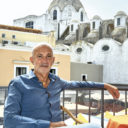
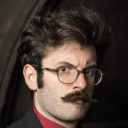


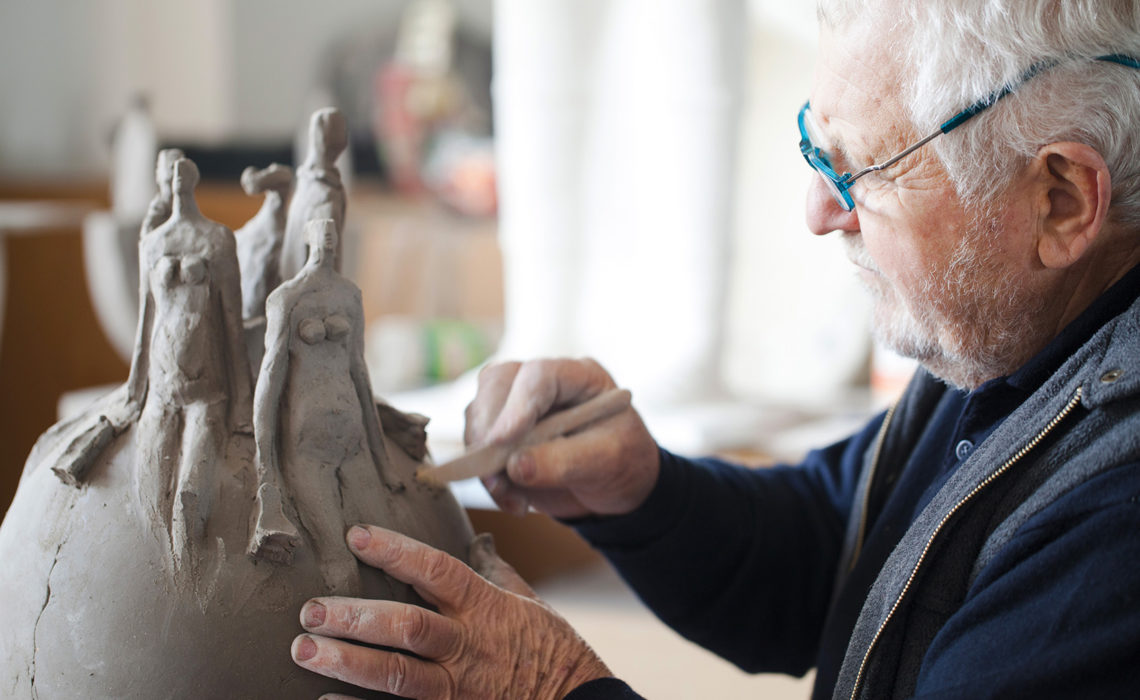
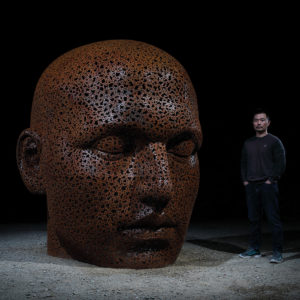
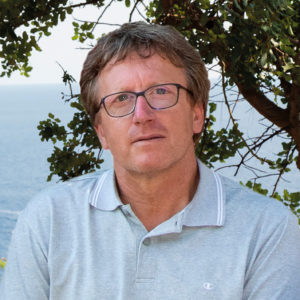
No Comments